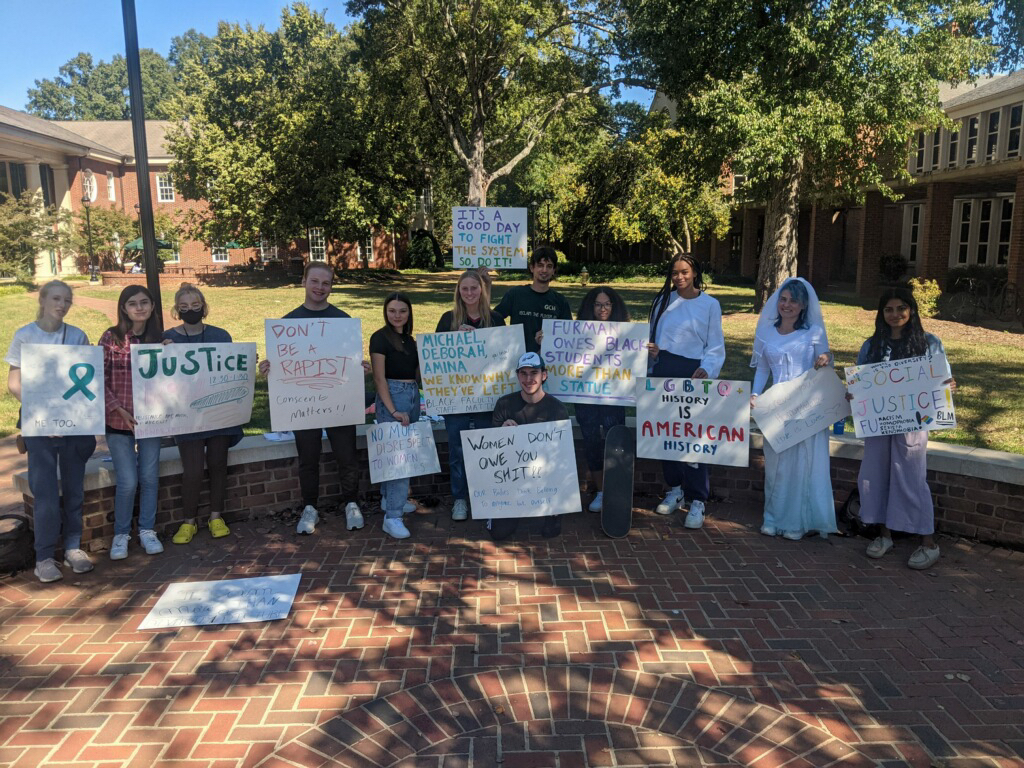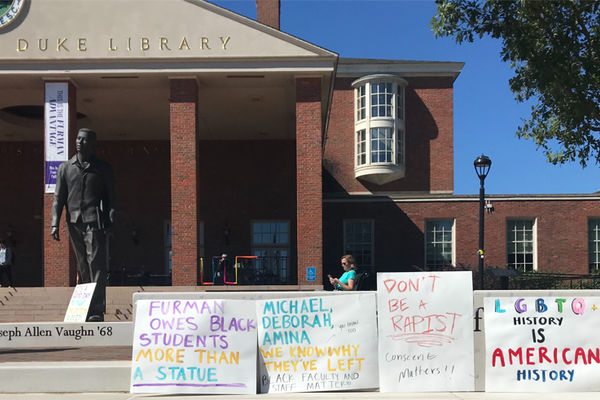Wed. October 20: “FURMAN OWES BLACK STUDENTS MORE THAN A STATUE.” The Furman Justice Forum (FJF) left a clear message on Joseph Vaughn Plaza following their first ever Justice Roll, an event organized to “create resistance art” and “build community.” Other signs read “I am more THAN a DIVERSITY PICTURE,” “Protect Trans Lives,” “WOMEN DON’T OWE YOU SHIT OUR Bodies Don’t Belong To anyone but Ourself,” and “DON’T BE A RAPIST Consent Matters!!” All the signs could be summed up, however, in the one that stood at Vaughn’s feet, which read: “IT’S A GOOD DAY TO FIGHT THE SYSTEM SO DO IT!”
According to syncDIN, FJF “creates a space for students at Furman [to] have an opportunity to learn about social injustices, to reflect on these issues, and feel called to take action in their communities.” They aim to “give students an opportunity to listen and understand justice issues while taking action to make their communities better.”
FJF president, Asha Marie ‘22—who is also the Furman Student Body President —planned the Justice Roll in tandem with two organization members, Nath Kapoor ‘23 and Miles Koniver ‘25.
The organizers did not initially set out to make a public statement on the Joseph Vaugn Plaza. According to Marie, the point of the event was simply to “create a social space for community building while listening to resistance music and making posters…. We planned to roll around on skateboards and bikes just to take up space and have fun.” Through Justice Roll, FJF aimed to connect FJF members and other students outside of their organization by creating space for dialogue about issues on campus.

From the outset, however, the event was intended to disrupt Furman’s homecoming week festivities and traditions. “We thought that having this event during homecoming... would mix things up and bring awareness to the thoughts and feelings of queer students and students of color,” Kapoor explained.
Mid-event Marie suggested that participants leave their polemical posters at the Joseph Vaughn Plaza. To her, Vaughn’s legacy is one of “social justice, civic engagement, justice, moving forward.” “Furman Justice Forum stands for that too,” Marie explained.
Marie also made it clear that though FJF stands with Joseph Vaughn, it does not stand with Furman’s representation of him. “I don’t like how we’ve told Joe Vaughn’s story,” she said, “I especially don’t think the quotes [on the plaza] do him or his legacy justice.”
Koniver made even bolder claims, arguing that Furman intentionally ignores important aspects of Vaughn’s life. “Vaughn ended up taking his own life when he was 45, and he was likely not straight,” said Koniver, “these are things that Furman doesn’t mention, and we want to change that. We want his entire story to be told.”
Perhaps the boldest claim FJF made, however, was on a sign that read “MICHAEL DEBORAH AMINA WE KNOW (you know too) WHY THEY’VE LEFT BLACK FACULTY AND STAFF MATTER.” Placed over the University’s original designation for the Vaughn statue—a quote that reads “I was a majority of one”—the sign seemed to suggest that there was a common factor connecting the recent departures of several Black faculty and staff. Marie confirmed.
“The ‘Michael, Deborah, Amina’ poster is calling out the fact that we underserve our Black faculty and staff. They often face racism and microaggressions and are asked to be racial symbols of progress while we don’t do a good enough job supporting them. And then when they have to go it hurts our Black students. It hurts our whole community.”
Now, organizers hope that the Administration will respond. “In creating the event,” Kapoor said, “we wanted to grab Admin attention in an effective way.” Marie petitioned Furman’s administration directly: “We call on Administration to continuously do better and to work with students to be better. Our value statements as a university support our actions today.”
Regardless of how the Administration responds, however, Marie aims to continue striving to make change. “As FJF’s president and the president of the student body, I’m not worried about a negative response from admin’s,” she said, “I hope they will be receptive and also know that we mean no harm.” “I made it very clear while running [for student body president] what I stood for and the type of difference I planned to make on campus. I am a president not of unity, but of justice and equity and progress... . Who am I as a leader if I am not fighting for justice and equity across campus and who am I if I am not helping make marginalized students’ voices heard?”
